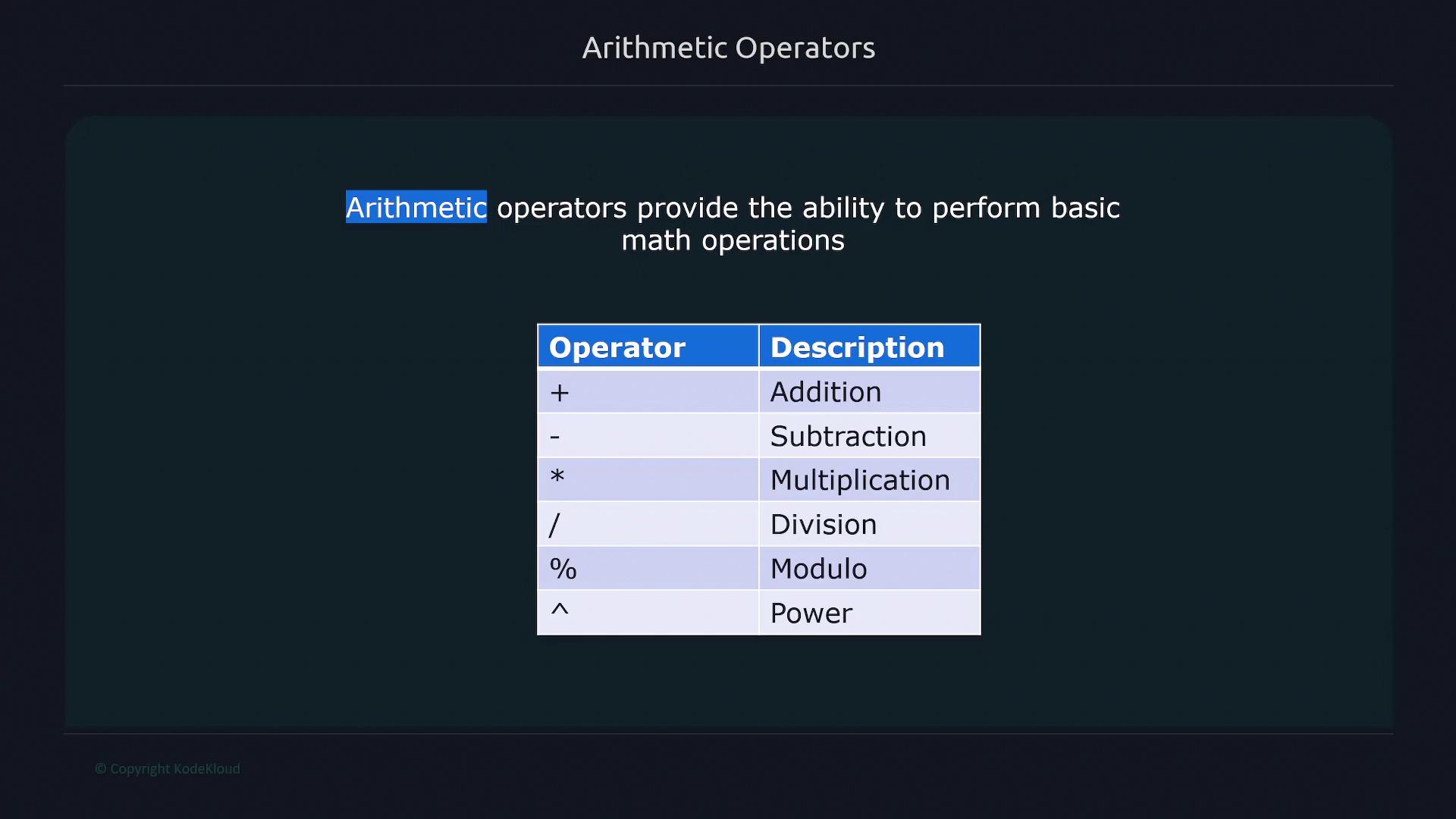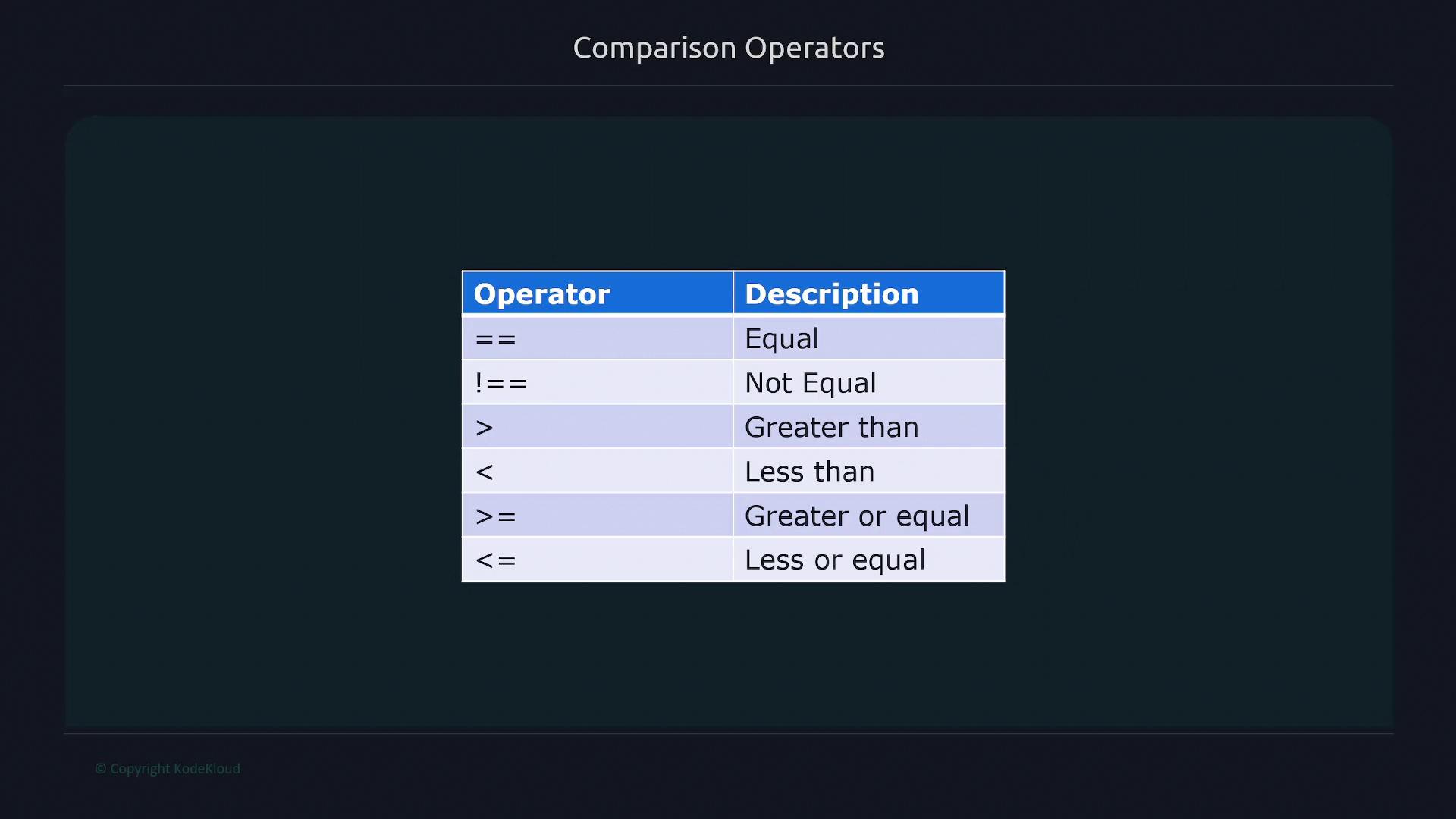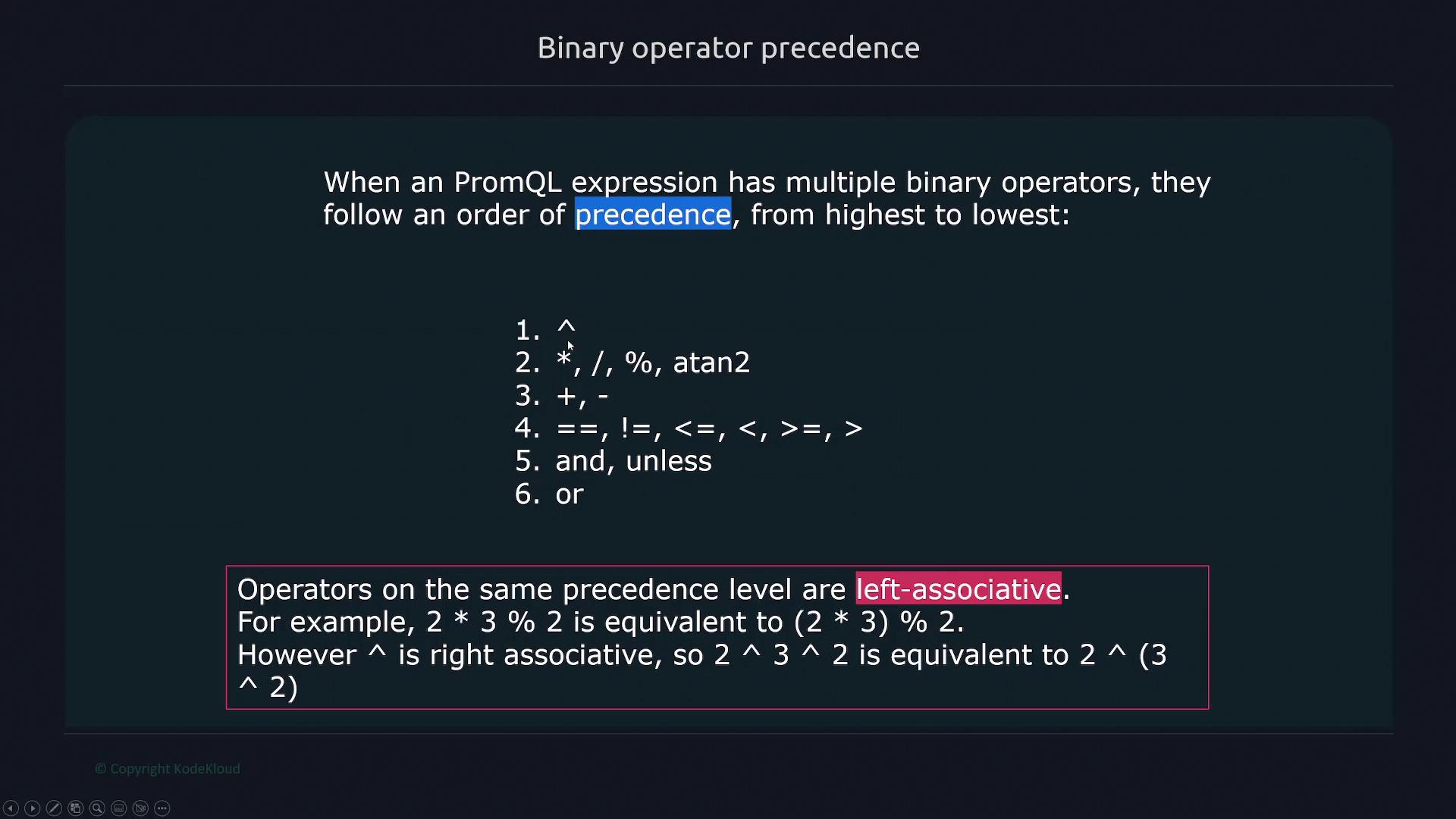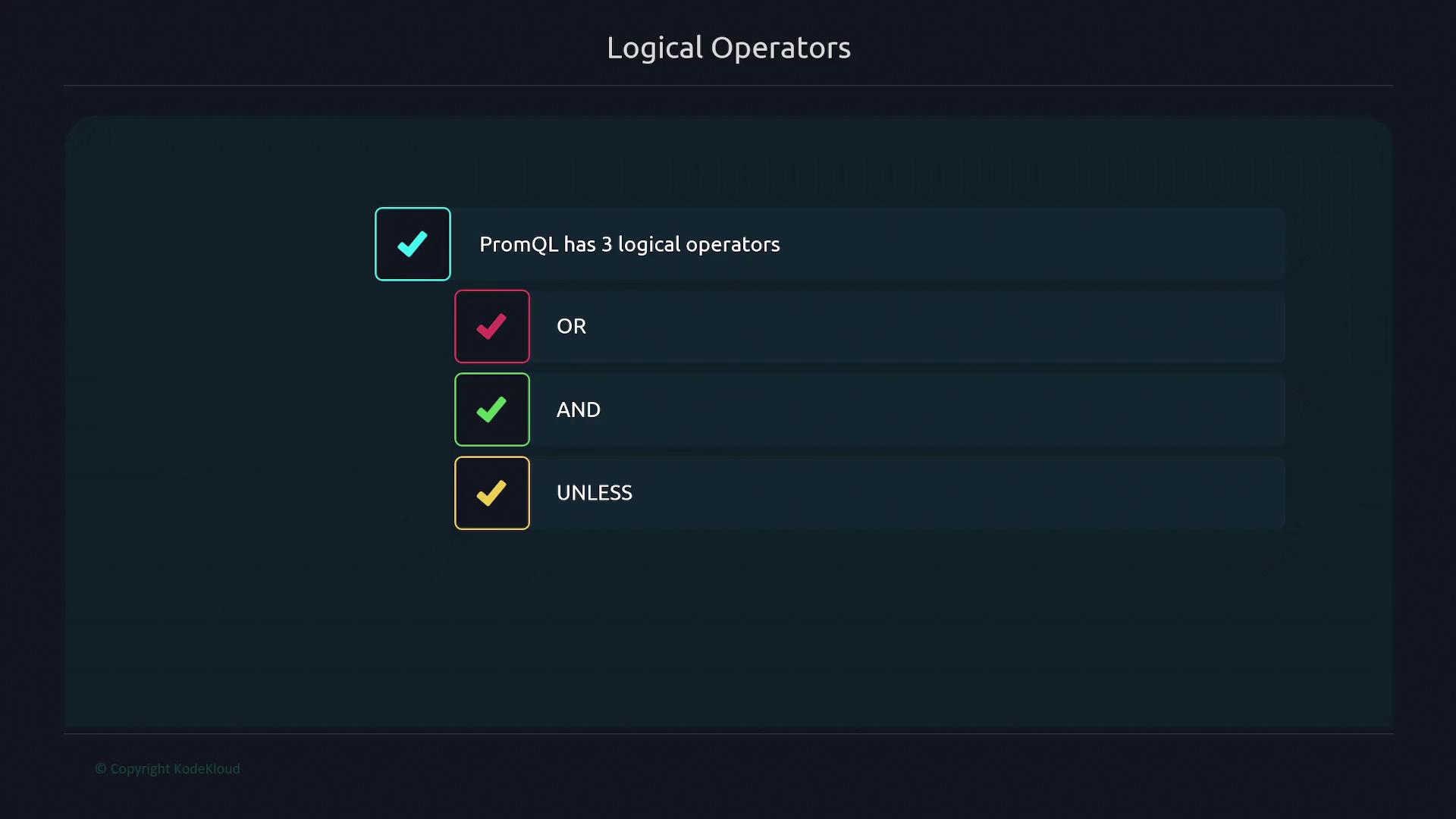Prometheus Certified Associate (PCA)
PromQL
Operators
This article provides an in-depth explanation of PromQL operators, including arithmetic, comparison, and logical operators. You will also learn about operator precedence and how to combine operators to construct powerful queries. The examples provided mirror behaviors in other programming languages, making them familiar and intuitive.
Arithmetic Operators
Arithmetic operators in PromQL let you perform basic mathematical operations such as addition, subtraction, multiplication, division, modulo, and exponentiation. For clarity, see the table below, which is represented by the following image:

Consider this example. Suppose you run:
$ node_memory_Active_bytes{instance="node1"}
2204815360
Appending a plus operator with 10 produces:
$ node_memory_Active_bytes{instance="node1"} + 10
This query adds 10 to the returned value. A common use case is converting a memory metric from bytes to kilobytes. For instance, the metric node_memory_Active_bytes outputs the active memory in bytes:
$ node_memory_Active_bytes
node_memory_Active_bytes{instance="node1", job="node"} 2204844032
node_memory_Active_bytes{instance="node1", job="node"} 2204887040
Divide by 1024 to convert bytes to kilobytes:
$ node_memory_Active_bytes / 1024
{instance="node1", job="node"} 2153168
{instance="node1", job="node"} 2153210
Note
Once you perform a mathematical operation on a metric, the result no longer retains the original metric name. This is important when transforming metrics for further analysis.
Comparison Operators
Comparison operators filter time series based on specified conditions. The following image summarizes the available comparison operators:

For example, to filter time series values greater than 100, you might execute:
$ node_network_flags
node_network_flags{device="enp0s3", instance="node1", job="node"} 5000
node_network_flags{device="enp0s3", instance="node2", job="node"} 4800
node_network_flags{device="lo", instance="node1", job="node"} 77
node_network_flags{device="lo", instance="node2", job="node"} 84
$ node_network_flags > 100
node_network_flags{device="enp0s3", instance="node1", job="node"} 5000
node_network_flags{device="enp0s3", instance="node2", job="node"} 4800
The Bool Operator
The bool modifier converts the outcome of comparisons into boolean values: returning 1 when the condition is true and 0 otherwise. This is especially useful for alerting scenarios.
Consider the metric node_network_receive_packets_total:
$ node_network_receive_packets_total
node_network_receive_packets_total{device="enp0s3", instance="node1", job="node"} 542
node_network_receive_packets_total{device="lo", instance="node1", job="node"} 220
node_network_receive_packets_total{device="enp0s3", instance="node2", job="node"} 8
node_network_receive_packets_total{device="lo", instance="node2", job="node"} 2
$ node_network_receive_packets_total >= 220
node_network_receive_packets_total{device="enp0s3", instance="node1", job="node"} 542
node_network_receive_packets_total{device="lo", instance="node1", job="node"} 220
Now, if you need to check file systems with less than 1,000 bytes available, start by viewing the metric output:
$ node_filesystem_avail_bytes
node_filesystem_avail_bytes{device="/dev/sda2", fstype="vfat", instance="node1", mountpoint="/boot/efi"} 53371
node_filesystem_avail_bytes{device="/dev/sda3", fstype="ext4", instance="node1", mountpoint="/"} 18771
node_filesystem_avail_bytes{device="tmpfs", fstype="tmpfs", instance="node1", mountpoint="/run"} 421
node_filesystem_avail_bytes{device="tmpfs", fstype="tmpfs", instance="node1", mountpoint="/run/lock"} 80012
node_filesystem_avail_bytes{device="tmpfs", fstype="tmpfs", instance="node1", mountpoint="/run/snapd/ns"} 872
Now, apply the bool modifier to filter file systems with less than 1,000 available bytes:
$ node_filesystem_avail_bytes < bool 1000
node_filesystem_avail_bytes{device="/dev/sda2", fstype="vfat", instance="node1", mountpoint="/boot/efi"} 0
node_filesystem_avail_bytes{device="/dev/sda3", fstype="ext4", instance="node1", mountpoint="/"} 0
node_filesystem_avail_bytes{device="tmpfs", fstype="tmpfs", instance="node1", mountpoint="/run"} 1
node_filesystem_avail_bytes{device="tmpfs", fstype="tmpfs", instance="node1", mountpoint="/run/lock"} 0
node_filesystem_avail_bytes{device="tmpfs", fstype="tmpfs", instance="node1", mountpoint="/run/snapd/ns"} 1
A return value of 1 signifies that the file system meets the condition of having less than 1,000 bytes available.
Operator Precedence
Understanding the order of evaluation is critical when combining multiple operators in a query. PromQL evaluates operators in the following order (from highest to lowest):
- Exponentiation (power operator; note that it is right-associative)
- Multiplication, Division, and Modulo (left-associative)
- Addition and Subtraction
- Comparison Operators
- Logical Operators
For instance, consider the expression:
2 * 3 % 2
Since multiplication and modulo are evaluated from left to right, first 2 * 3 is computed, and then the modulo operation follows. Conversely, the exponentiation operator (^) evaluates the right-hand side first, given its right-associative nature.
The following diagram outlines the precedence of PromQL binary operators:

Logical Operators
PromQL supports three key logical operators: OR, AND, and UNLESS. These operators help in refining your queries by combining multiple conditions.

AND Operator
The AND operator returns only the time series that satisfy both specified conditions. For example, to list file systems with available bytes greater than 1,000 and less than 3,000, you can run:
$ node_filesystem_avail_bytes
node_filesystem_avail_bytes{instance="node1", job="node", mountpoint="/home"} 53371
node_filesystem_avail_bytes{instance="node1", job="node", mountpoint="/var"} 1771
node_filesystem_avail_bytes{instance="node1", job="node", mountpoint="/etc"} 421
node_filesystem_avail_bytes{instance="node1", job="node", mountpoint="/home"} 80012
node_filesystem_avail_bytes{instance="node1", job="node", mountpoint="/home"} 2872
$ node_filesystem_avail_bytes > 1000 and node_filesystem_avail_bytes < 3000
node_filesystem_avail_bytes{instance="node1", job="node", mountpoint="/var"} 1771
node_filesystem_avail_bytes{instance="node1", job="node", mountpoint="/home"} 2872
OR Operator
The OR operator fetches time series that satisfy at least one of the conditions. For instance, to select file systems with available bytes either less than 500 or greater than 70,000:
$ node_filesystem_avail_bytes
node_filesystem_avail_bytes{instance="node1", job="node", mountpoint="/home"} 53371
node_filesystem_avail_bytes{instance="node1", job="node", mountpoint="/var"} 18771
node_filesystem_avail_bytes{instance="node1", job="node", mountpoint="/etc"} 421
node_filesystem_avail_bytes{instance="node1", job="node", mountpoint="/opt"} 80012
$ node_filesystem_avail_bytes < 500 or node_filesystem_avail_bytes > 70000
node_filesystem_avail_bytes{instance="node1", job="node", mountpoint="/etc"} 421
node_filesystem_avail_bytes{instance="node1", job="node", mountpoint="/opt"} 80012
UNLESS Operator
The UNLESS operator works by returning time series elements from the left-hand side that do not have a corresponding match on the right-hand side. For example, to display file systems with available bytes greater than 1,000 unless they are also greater than 30,000:
$ node_filesystem_avail_bytes
node_filesystem_avail_bytes{instance="node1", job="node", mountpoint="/home"} 53371
node_filesystem_avail_bytes{instance="node1", job="node", mountpoint="/var"} 1771
node_filesystem_avail_bytes{instance="node1", job="node", mountpoint="/etc"} 421
node_filesystem_avail_bytes{instance="node1", job="node", mountpoint="/home"} 80012
node_filesystem_avail_bytes{instance="node1", job="node", mountpoint="/home"} 2872
$ node_filesystem_avail_bytes > 1000 unless node_filesystem_avail_bytes > 30000
node_filesystem_avail_bytes{instance="node1", job="node", mountpoint="/var"} 1771
node_filesystem_avail_bytes{instance="node1", job="node", mountpoint="/home"} 2872
Additional Examples and Combining Operators
Let's consider another metric, node_arp_entries, which might yield a value of 2:
$ node_arp_entries
node_arp_entries{device="enp0s3", instance="192.168.1.168:9100", job="node"} 2
To adjust this value by adding 50, simply perform:
$ node_arp_entries + 50
node_arp_entries{device="enp0s3", instance="192.168.1.168:9100", job="node"} 52
Another common scenario involves filtering file systems based on available bytes. For example, to display only those file systems with available bytes greater than 6 million, or to refine the filter by combining multiple conditions (such as selecting file systems below one billion bytes), you can leverage the AND and OR operators accordingly. Here’s an demonstration:
$ node_filesystem_avail_bytes{device="/dev/sda2", fstype="vfat", instance="192.168.1.168:9100", job="node", mountpoint="/boot/efi"}
531341312
$ node_filesystem_avail_bytes{device="/tmpfs", fstype="tmpfs", instance="192.168.1.168:9100", job="node", mountpoint="/run"}
726482944
$ node_filesystem_avail_bytes{device="/tmpfs", fstype="tmpfs", instance="192.168.1.168:9100", job="node", mountpoint="/run/snapd/ns"}
726482944
$ node_filesystem_avail_bytes{device="/tmpfs", fstype="tmpfs", instance="192.168.1.168:9100", job="node", mountpoint="/run/user/127"}
727838720
Using the OR operator, you could select time series that either fall below the lower threshold of 6 million or exceed the upper threshold of one billion, providing flexible query options for your monitoring needs.
Conclusion
This article provided an overview of arithmetic, comparison, and logical operators in PromQL, along with detailed examples illustrating how to combine them efficiently. By understanding operator precedence and the impact of mathematical operations on your metrics, you can craft accurate and robust queries for your monitoring environment.
For more information, check out the Prometheus Documentation and other related resources.
Watch Video
Watch video content